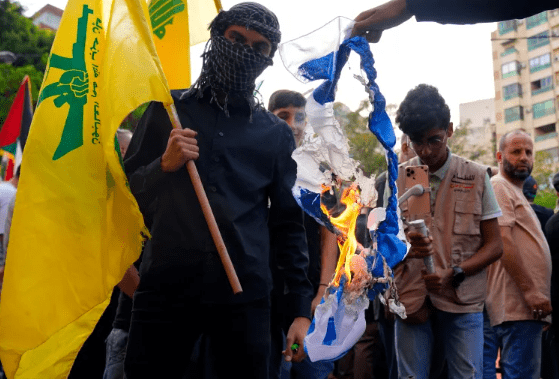
As Israeli advances into Gaza continue, they — for the first time — appear to be coming from more than one direction. It is yet unclear whether these are still reconnaissances-in-force or if Israel chose to make the ground invasion a “rolling operation” increasing force levels gradually over time.
For Israel’s military, such a careful approach may prove more practical than an all-out offensive. If tactics are adapted daily to the situation on the ground, the successful ones can be replicated elsewhere. From a political perspective, it buys generals time to see how Israeli Prime Minister Benjamin Netanyahu’s position develops.
In past conflicts, most Israelis braced together, avoiding questioning their government too much. Now, many accuse Netanyahu of being responsible for the October 7 attacks. He has adamantly retorted that “this is a time for war.”
But while he was almost certainly referring to the Israeli southern front in Gaza, his intransigence may see the opening of another one, in the north.
On Monday, I suggested that regional countries do not want to join in. However, states are not the only entities that have armies. In Israel’s northern neighbour, Lebanon, one such non-state military, Hezbollah, is stronger than the national army. And not under the control of the central government.
Hezbollah, meaning Party of God, was created in the 1980s, during the civil war in Lebanon, to unite various factions of minority Shia Muslims and provide social services as the state had disintegrated. Encouraged by initial success and by the backing of Iran, Hezbollah developed an armed wing that quickly became a formidable fighting force.
So formidable that it can be said to be the only Arab force ever to defeat Israel in battle. In 2000, Hezbollah resistance forced Israel to end its occupation of South Lebanon.
Israelis angrily refuse to call their withdrawal after a stay of 15 years a defeat, but they admit that Hezbollah was a major factor in their decision. In 2006, in a one-month war with Israel, Hezbollah showed an unprecedented and unexpected degree of sophistication and capability when it attacked Israeli corvette Hanit, then one of the three most modern and capable ships, with a Chinese-built land-sea missile.
Hassan Nasrallah, overall leader of Hezbollah, has boasted of 100,000 fighters under his command. He is likely exaggerating: Most experts believe the figure to be approximately 60,000 but pure numbers are not the militia’s main asset.
Its strengths lie in proper military organisation and discipline and dedication that is without doubt superior to most state armies. It also has an arsenal of weapons well suited to the infiltration-capable small-team light-infantry tactics that it learned by fighting Israel. Due to its enemy’s superiority in air force and armour, Hezbollah has no piloted aircraft nor tanks, although it operated a battalion-size armoured unit in the Syrian war, to gain experience.
But it has a potent array of missiles and rockets, heavier and longer ranged than those that Hamas uses, and capable field artillery. Most weapons are believed to have been originally supplied by and through Iran. They were supplemented in range and numbers in the Syrian war where Hezbollah aided official Syrian forces of President Bashar al-Assad.
The dedication and determination of Hezbollah fighters resisting Israeli attacks in Beirut in 2006 caused Israel to formulate the much-criticised “Dahya doctrine” of total aerial destruction that we are now seeing every day in Gaza. It was named after the Beirut neighbourhood that first met that fate. Israeli General Gadi Eizenkot explained it as a plan to harm the civilians as the only way of stopping the fighters, by using disproportionate power against any civilian structure that they could use. It failed to stop Hezbollah.
Being an enemy it knows and respects, Hezbollah compelled Israel to deploy massive reinforcements on the Lebanon border, boosting the resident Golani brigade to probably 100,000 soldiers or more. It knows that, unlike Hamas – which can only launch rockets, Hezbollah has a realistic possibility of advancing into Israel and holding ground taken.
But Hezbollah does not need to attack across the Blue Line demarcating the two countries. By its very existence, it is what militaries call an “army-in-waiting”. Israel must keep its assets in the north to counter, and deter, any potential big push that would be a serious military, and even bigger political, problem for Israel.
The current situation and most possible developments seem to favour Hezbollah. If it just maintains the current low-level engagement, it blocks significant Israeli military assets.
It can choose to respond to the continued destruction of Gaza by launching a relatively moderate series of rocket attacks against Israel without significant risk of provoking an Israeli offensive into Lebanon. Coordinated missile attacks against targets that Hamas can reach, say in Tel Aviv, would put the Iron Dome defences under enormous strain. And Hezbollah could also bombard Hamas-safe cities in the north like Haifa or Kiryat Shmona.
Such modest levels of escalation would win Hezbollah popularity in the Arab and Muslim world as the only non-Palestinian force joining the Gaza Palestinians’ fight.
Yet, all of this is only valid if events on the ground follow some rationale. But rational behaviour is fragile and of limited use in situations ruled by fear, frustrations, hatred or other strong collective emotions.
The current tense-but-stable very-low-intensity standoff at Israel’s northern border appears to be the most convenient situation for both sides, and they both know it. But both must be worried about the possibility that a small unpredictable flash ignites a big fire that neither side can contain.






